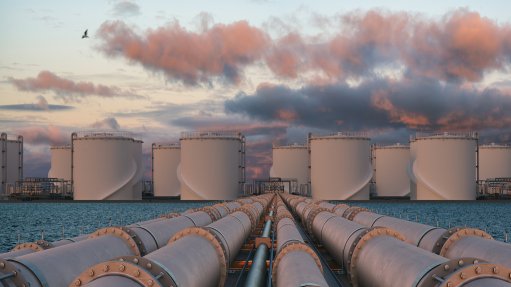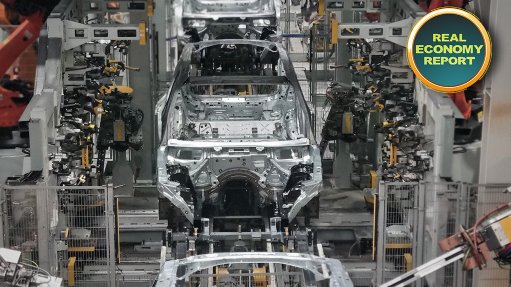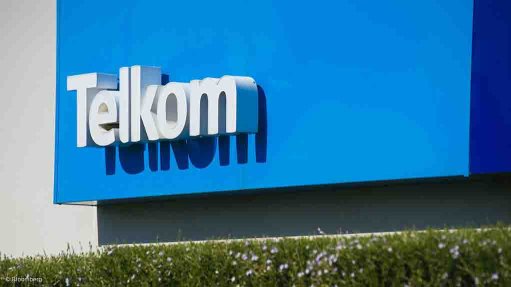Platinum group metals can play essential decarb role beyond hydrogen – Heraeus

Heraeus VP Dr Philipp Walter interviewed by Mining Weekly's Martin Creamer. Video: Darlene Creamer.
JOHANNESBURG (miningweekly.com) – Platinum group metal (PGM) catalysis can play an essential decarbonising role beyond hydrogen generation, where its use in proton exchange membrane (PEM) technology for water electrolysis and fuel cells is being increasingly seen as essential.
As has been reiterated for some time, PGMs and hydrogen belong together, and the global Hydrogen Council's latest report, Hydrogen Insights 2024, highlights the rapid expansion and evolving landscape of the green hydrogen sector, with investment in hydrogen projects reaching final investment decision or FID status rising from $10-billion in 2020 to $75-billion in 2024.
But now being posited, too, is that the decarbonising effect of these largely Southern African-sourced special PGM metals could well extend significantly beyond planet-protecting green hydrogen into the likes of carbon dioxide biomass as well perhaps even polymer waste.
To treat these, PGM catalysis can, once again, play an essential role.
This is the main takeaway from Mining Weekly’s interview with Dr Philipp Walter, the executive VP Business Line Hydrogen Systems, Global Business Unit Heraeus Precious Metals, now returned from his recent presentation at the New York Platinum Week. (Also watch attached Creamer Media video.)
On the one hand, PGMs main applications are as electro catalysts for electrolysers, and on the other hand for fuel cells, which turn the hydrogen back into green electricity.
Mining Weekly: Why is green hydrogen such a key solution when it comes to clean fuel, energy storage, decarbonisation, and the greening crucial materials?
Walter: Hydrogen is an energy vector in this respect, so it has an ability, when being formed by means of electrolysis, to store energy and this stored energy can then either be released through fuel cells, through chemicals or through use as fuels, so it can be burned, and then you have only water as a byproduct and not any other carbon-containing compounds.
New York heard that PGMs are building a toolbox for hydrogen applications. Tell us about that.
PGMs are a toolbox because of their synergistic effects. They have a different cost profile, and basically, depending on a certain target application, what you can do is mix PGMs to achieve a certain target property profile, including a certain cost profile, which has been done in many instances in the past for emission catalysts.
What is the relationship between water electrolysis and PGMs?
There are different water electrolysis technologies, and a lot of these technologies apply PGMs. The major use, however, is foreseen for PEM electrolysis, where platinum is used on the cathode for what is called the hydrogen evolution reaction, and iridium, or iridium and ruthenium, are used on the anode for the oxygen evolution reaction.
What is the latest when it comes to hydrogen electrolyser development - how competitive is hydrogen electrolysis?
Water electrolysis, and PEM electrolysis, which is where the PGMs are predominantly used, is developing, and one of the clear targets is to reduce the cost. PGMs bear a certain cost in an electrolyser, but by means of thrifting as well as advanced development, these costs can be reduced by the load of PGMs being reduced, without sacrificing the performance of the respective electrocatalysts for the hydrogen evolution and the oxygen evolution reaction.
Is the world accepting this?
The world is increasingly accepting the fact that PGMs are essential parts of the PEM technology for water electrolysis as well as fuel cells. There are often attempts to reduce, or even to replace PGMs, but, so far, the peculiar electrochemical stability of PGMs, together with their activity, makes them very hard to replace, so industry is, I think, accepting the fact that PGMs are an essential part of PEM technology.
LATEST PGM-LINKED HYDROGEN ADVANCES
Hydrogen Insights 2024 reports that the global hydrogen project pipeline has increased sevenfold since 2020 – from 228 projects in 2021 to 1 572 in 2024 – with the sector recording a 20-fold increase in investments at the front end engineering design, or FEED, stage since 2020.
South Africa-linked AP Ventures’ portfolio company Hypermotive has just announced that it is collaborating with Honda to develop a scalable hydrogen fuel cell power system. Using Honda’s fuel cell system and Hypermotive’s ecosystem of smart hardware products is described as marking an important milestone for the Hypermotive team on their way to support the adoption of fuel cell systems in various sectors.
The World Platinum Investment Council recently reported that Siemens Energy has been contracted to supply and install the electrolysers needed for the 100 MW Hamburg Green Hydrogen Hub to be built at the site of a decommissioned coal-fired power station in the Moorburg district. The order is for six units of Siemens Energy’s latest PEM electrolyser model. The stacks will be fabricated at the company’s new Gigafactory in Berlin and assembled at its Muhlheim site and at a European partner.
Meanwhile, Fuel Cell Works reports that Toyota Motor Corporation executive VP Shinichi Yasui highlighted advancements at IAA Transportation Hannover 2024, emphasising hydrogen fuel cell technology's potential for medium- and heavy-duty vehicles.
Moreover, the recent Hydrogen UK Parliamentary Reception brought together MPs and policymakers to discuss what industry needs from government to progress the UK hydrogen industry.
The South Africa-linked German company Hydrogeneous reports that the flexibility of its liquid organic hydrogen carrier (LOHC) technology offers hydrogen solutions. LOHC's versatility is said to allow for its integration into various sectors, from transportation and energy storage to industrial processes as the released hydrogen reaches fuel cell grade hydrogen purity. LOHC can be transported and stored using existing liquid fuel infrastructure, including ships, tanks and trucks. By offering a versatile and adaptable solution for hydrogen transport and storage, LOHC is said to unlock the full potential of hydrogen as a clean and sustainable energy source.
Hydrogen Industry VN report that Deloitte identifies clean hydrogen as crucial for the Asia Pacific region to meet net zero targets. The new 'Clean Hydrogen in Asia Pacific: Fuel for Thought' study states that switching to clean hydrogen is vital for decarbonising and achieving net zero emissions in the region.
David Scrimgeour MBE reports that H2 Energy Europe and the German TSO Ontras Gastransport GmbH are planning to transport green hydrogen from the H2 Energy 1 GW hydrogen facility in Esbjerg, Denmark, to the German industrial zones of Salzgitter, Berlin, Eisenhüttenstadt, Magdeburg and Leipzig-Halle.
"This project is crucial to meeting Germany’s growing demand for hydrogen, estimated at between 95 and 130 TWh per year by 2030. The planned production capacity at Esbjerg is around 90,000 tonnes of green hydrogen per year," Scrimgeour says on LinkedIn.
"This production capacity is significant in a context where Germany expects to import between 50% and 70% of its hydrogen needs. The integration of the Danish hydrogen plant into the Ontras gas transmission network would enable us to meet part of this growing demand,” he adds.
Engineering Centre of Excellence head Tauqeer Ahmed describes Africa's potential in the green hydrogen revolution as being undeniable. With abundant sunshine, vast windswept plains, he highlights that the continent boasts the natural resources to become a global leader in clean energy production. But translating that potential into reality requires a concerted effort, and the recent collaboration between Durban University of Technology and the South African National Energy Development Institute is a shining example of why collaboration is key to accelerating the green hydrogen economy, Ahmed reports.
“Africa's green hydrogen journey has just begun. By fostering collaboration between government entities, universities, and the private sector, we can unlock the immense potential of this clean energy source. Imagine a future where African ports become green hydrogen hubs, powering ships and industries with clean fuel. It's an achievable dream, but only through collaborative action,” he adds.
Honda Motor deputy GM Europe business planning and development Ingo Nyhues says there is a great opportunity with the maritime industry to demonstrate the performance and efficiency of a hydrogen solution such as X-M1, which he sees as a significant step towards achieving carbon neutrality in this sector.
Hydrogen solutions developer Fabrum and energy and metals company Fortescue have successfully commissioned Australia’s largest liquid hydrogen plant at Fortescue’s Green Energy Hub, in Christmas Creek, Western Australia.
Fabrum collaborated with Fortescue to deliver an end-to-end hydrogen ecosystem for Fortescue to decarbonise its mining operations.
The facility comprises a hydrogen liquefication plant, liquid hydrogen storage and a liquid hydrogen refuelling station. It is capable of producing about 350 kg of liquid hydrogen a day and has 600 kg of storage capacity.
Liquid hydrogen from the plant will be used to power Fortescue’s zero-emissions mining equipment prototypes, including its Offboard Power Unit and its hydrogen-powered haul truck prototype.
Article Enquiry
Email Article
Save Article
Feedback
To advertise email advertising@creamermedia.co.za or click here
Comments
Press Office
Announcements
What's On
Subscribe to improve your user experience...
Option 1 (equivalent of R125 a month):
Receive a weekly copy of Creamer Media's Engineering News & Mining Weekly magazine
(print copy for those in South Africa and e-magazine for those outside of South Africa)
Receive daily email newsletters
Access to full search results
Access archive of magazine back copies
Access to Projects in Progress
Access to ONE Research Report of your choice in PDF format
Option 2 (equivalent of R375 a month):
All benefits from Option 1
PLUS
Access to Creamer Media's Research Channel Africa for ALL Research Reports, in PDF format, on various industrial and mining sectors
including Electricity; Water; Energy Transition; Hydrogen; Roads, Rail and Ports; Coal; Gold; Platinum; Battery Metals; etc.
Already a subscriber?
Forgotten your password?
Receive weekly copy of Creamer Media's Engineering News & Mining Weekly magazine (print copy for those in South Africa and e-magazine for those outside of South Africa)
➕
Recieve daily email newsletters
➕
Access to full search results
➕
Access archive of magazine back copies
➕
Access to Projects in Progress
➕
Access to ONE Research Report of your choice in PDF format
RESEARCH CHANNEL AFRICA
R4500 (equivalent of R375 a month)
SUBSCRIBEAll benefits from Option 1
➕
Access to Creamer Media's Research Channel Africa for ALL Research Reports on various industrial and mining sectors, in PDF format, including on:
Electricity
➕
Water
➕
Energy Transition
➕
Hydrogen
➕
Roads, Rail and Ports
➕
Coal
➕
Gold
➕
Platinum
➕
Battery Metals
➕
etc.
Receive all benefits from Option 1 or Option 2 delivered to numerous people at your company
➕
Multiple User names and Passwords for simultaneous log-ins
➕
Intranet integration access to all in your organisation



















